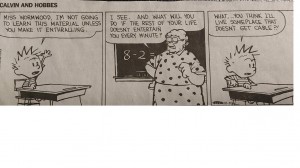A few weeks ago I was told, with a lot of detail, by the Head of a very good school, the reasons why computers were not allowed in the classroom and the reasons why they don’t even teach the students how to use the computer.
I understood the second part perfectly: students are tech savvy; they often know more than their teachers about how to write a blog or design a web page. They use social media, text editors and photo editing almost daily. Those things hide no secrets for them.
Therefore, why should the school waste time on teaching something that the students already know?
I must say I was surprised by the first statement. The use of the computer as a teaching tool was rejected in order to emphasize cultural literacy and critical thinking. This way, the burden of teaching was completely on the teacher’s shoulders: relying on his or her knowledge, her/his teaching skills and her/his ability to reach the mind and soul of her/his students. Their reasoning for this was that computers and the Internet would distract the students from the main objective: learning.
It is not accurate to say that kids and teens are interested on the new “smart devices”; telephones, tablets, TV sets, watches and now also goggles. The right verb to express their relation with these smart devices is love. They love those devices which they use daily as an extension of their body. How was it possible, some years ago, to meet a friend in the correct corner of the street without sending him or her seven messages like the following?: “I am almost there”. “just crossing the road” ,”but the police is cutting the street” ,”so I will be late”, “I am at the corner”…….
Educational researcher Sugata Mitra has done some research in this field with the “Hole in the Wall” experiments. [1] reaching the conclusion that children can teach themselves and each other using the world wide web contents without the formal supervision of a teacher.
It requires some conditions for this to happen:
- Free access to the world-wide-web
- Cooperative learning: four children per computer interacting and learning- teaching together
- A challenge: the subject to be learnt must be difficult, unknown by the students
- And including “The Granny method” “What’s that?” “Well, what you’ve got to do is stand behind them and admire them all the time. Just say to them, ‘That’s cool. That’s fantastic. What is that? Can you do that again? Can you show me some more?’
The results of this self-teaching process is that children learn in depth, real learning[2] of very tough and complex subjects[3], reaching the same grades that they would get if they had a teacher.[4]
Watch the complete conference of Sugata Mitra.
This phenomenon is happening not only in children and teens, but it happens also in adult people. Just watch what is happenning with the MOOC (Massive Open Online Course). There are more courses every day, more universities involved, more subjects taught in this open and online way.
The attendance to those courses offered by the best universities in the world through different platforms or MOOC providers as Coursera, Udacity, Edx, [6] is truly massive[5]. Have you enroll any of these courses yet? I have. I am taking three of those MOOC. Sometimes I ask myself how it is possible; I am very busy now with my current job and I have managed to take three courses! And those courses are really demanding. They require a lot of personal work and homework. Why then am I taking three? This is because the courses are really good addressing current affairs, the teachers are outstanding and the courses are free!
The grades reached by the students are also better than the one in the in person classes. The failure rate has decreased by 30% [7]
This is known data, are we educators going to reject the use of this powerful learning tool or are we going to use it to the maximum?
[2] “The teachers said, “Is this deep learning?” I said, “Well, let’s try it. I’ll come back after two months. We’ll give them a paper test — no computers, no talking to each other, etc.” The average score when I’d done it with the computers and the groups was 76 percent. When I did the experiment, when I did the test, after two months, the score was 76 percent.” Sugata Mitra at TED talk “Child Driven Education”
[3] So I said, “For two months, you were looking at stuff you didn’t understand?” So a 12 year-old girl raises her hand and says, literally, “Apart from the fact that improper replication of the DNA molecule causes genetic disease, we’ve understood nothing else.” Sugata Mitra at TED talk “Child Driven Education”
[4] “The scores went up to 50, which is what the posh schools of New Delhi, with a trained biotechnology teacher were getting.” Sugata Mitra at TED talk “Child Driven Education”
[5] “ 155,000 students from 162 countries enrolled in this course. And we had no marketing budget. Now, 155,000 is a big number. This number is bigger than the total number of alumni of MIT in its 150-year history. 7,200 students passed the course, and this was a hard course. 7,200 is also a big number. If I were to teach at MIT two semesters every year, I would have to teach for 40 years before I could teach this many students.” Anant Argwal en TED talks “Why massively open online courses still matter”
[6] Here you are a wonderful article comparing the htree platforms http://www.skilledup.com/blog/the-best-mooc-provider-a-review-of-coursera-udacity-and-edx/
[7] “So traditionally, semester upon semester, for the past several years, this course, again, a hard course, had a failure rate of about 40 to 41 percent every semester. With this blended class late last year, the failure rate fell to nine percent. So the results can be extremely, extremely good” Ver http://new.ted.com/talks/anant_agarwal_why_massively_open_online_courses_still_matter


Leave a Reply